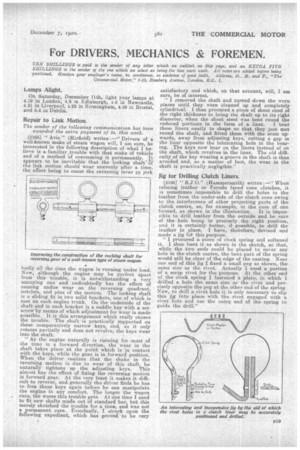For DRIVERS, MECHANICS & FOREMEN.
Page 29

If you've noticed an error in this article please click here to report it so we can fix it.
TEN SHILLINGS u paid to the sender of any letter SHILLINGS to the sender of the one which we select as published. Mention your employer's name, in confidence. Commercial Motor," 7-15, R
which we publish on this page, and an EXTRA FIVE being the ben each week. All notes are edited before being as evidence of good faith, Address, D., M. and F., .'The osebery Avehue, London, E.C.. 1.
Lamps Alight.
On Saturday, December 11th, light your lamps at 4.19 in London, 4.8 in Edinburgh, 4.6 in Newcastle, 4.21 in Liverpool, 4.22 in Birmingham, 4.29 in Bristol, and 5.4 in Dublin.
Repair to Link Motion.
The sender of the following conimunication has been awarded the extra payment of 5s, this week.
[2165] " Avis " (Mirfie1d) writes :—" Drivers of a well-known make of steam wagon will, I am sure, be interested in the following description of what I believe is a familiartrouble with that make of vehicle and of a method of overcoming it permanently. It appears to be inevitable that the locking shaft of the link motion should wear unevenly after a time, the effect being to cause the reversing lever to jerk badly all the time the wagon is running under load. Now, .although the engine may be perfect apart from this trouble; it is notwithstanding a very annoying one and undoubtedly has the effect of causing undue wear on the reversing quadrant, notches, and pins of the motion. The locking shaft is a sliding fit in two solid brackets, one of which is cast on each engine trunk. On the underside of the shaft and in each bracket is a saddle key with a setscrew by means of which adjustment for wear is made possible. It is this arrangement which really causes the trouble. The shaft is practically supported on these comparatively narrow keys and, as it only rotates partially and does not revolve, the keys wear into the shaft.
"As the engine naturally is running for most of the time in a forward direction, the wear in the shaft takes place at the point which is in contact with the keys, while the gear is in forward position. When the driver realizes that the shake in the reversing motion is due to wear of this shaft, he naturally tightens up the adjusting keys. This almost has the effect of fixing the reversing motion in forward gear. At the very least it makes it difficult to reverse, and generally the driver finds he has to free these keys again before he can manipulate the engine in any comfort. The longer the wagon runs, the worse this trouble gets. At one time I used to fit new shafts made out of standard bar, but this merely skotched the trouble for a time, and was not a permanent cure. Eventually, I struck upon the following expedient, which has proved to be very satisfactory and which, on that account, will, I am sure, be of interest.
" I removed the shaft and turned down the worn places until they were cleaned up and completely cylindrical. I then procured a piece of sheet steel of the right thickness to bring the shaft up to its right diameter, when the sheet steel was bent round the
reduced portions in the form of a liner. I bent these liners neatly to shape so that they just met round the shaft, and fitted them with the seam upwards, away from adjusting keys; cutting a gap in the liner opposite the lubricating hole in the bearing. The keys now bear on the liners instead of on the shaft, which revolves in the liner. The old difficulty of the key wearing a groove in the shaft is thus avoided and, as a matter of fact, the wear in the shaft is practically negligible."
Jig for Drilling Clutch Liners. [2166] " B.J.0." (Hammersmith) writes When
relining leather or Ferodo faced cone clutches, it is sometimes impassible to drill the holes in the leather from the under-side of the clutch cone owing to the interference of other projecting parts of the clutch centre, as, for example, in the case of one formed, as shown in the illustration. It is impossible to drill leather from the outside and be sure of the hole being in precisely the right position, and it is, certainly better, if possible, to drill the leather in place. I have, therefore, devised and made a jig fatthis purpose.
" I procured a piece of clack spring and softened it. I then bent, it as shown in the sketch, so that, while the two ends could be placed to cover any hole in the clutch centre, the bent part of the spring would still be clear of the edge of the casting. Near one end of this jig I fixed a small peg as shown, the same size as the rivet. Actually I used a portion of a scrap rivet for the purpose. At the other end of the clock spring I fastened a .plate, in which I drilled a hole the same size as the rivet and pre. oisely opposite the peg at the other end of the spring. Now, to drill a rivet hole it is only necessary to slip this jig into place with the rivet engaged with a rivet hole and use the outer end of the spring to guide the drill."






























